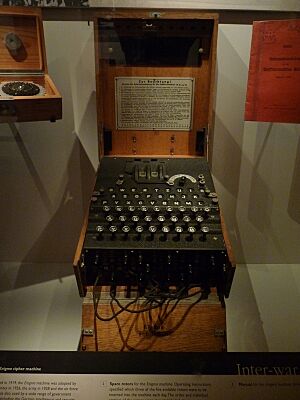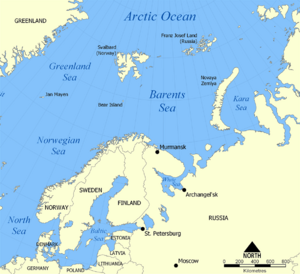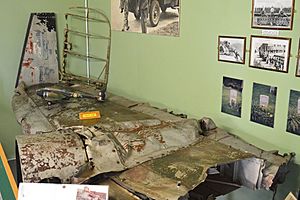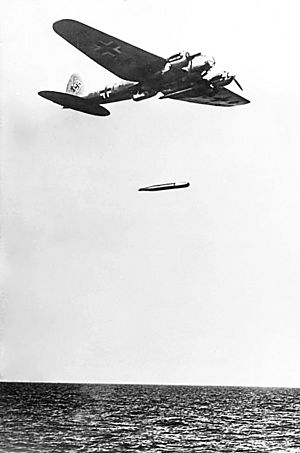Operation Orator facts for kids
Quick facts for kids Operation Orator |
|||||||
|---|---|---|---|---|---|---|---|
| Part of Arctic naval operations of the Second World War | |||||||
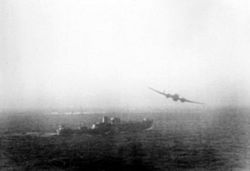 A Hampden TB.1 of the Leuchars Wing makes a torpedo attack on a German vessel during the Second World War. (A photograph taken by a member of 18 Group on an unrelated operation.) |
|||||||
|
|||||||
| Belligerents | |||||||
| Commanders and leaders | |||||||
| Units involved | |||||||
|
Search & Strike Force
|
Marinegruppenkommando Nord (Naval Group Command North) Jagdgeschwader 5 (Fighter Wing 5) |
||||||
| Strength | |||||||
| RAAF–RAF 32 long-range torpedo bombers 8 long-range maritime patrol aircraft 5 long-range reconnaissance aircraft |
Kriegsmarine 1 battleship (Tirpitz) 3 cruisers (Admiral Scheer, Admiral Hipper, Köln) 4 destroyers Luftwaffe 35–60 fighters (II./JG 5 and III./JG 5) |
||||||
| Casualties and losses | |||||||
| Air crew killed: c. 18 POW c. 12 Aircraft: 9 torpedo bombers (en route to USSR) 2 PRU Spitfires |
|||||||
Operation Orator was a secret mission during World War II in September 1942. Its goal was to protect an Allied convoy, called Convoy PQ 18, from a powerful German battleship named Tirpitz. British and Australian air forces flew to temporary bases in North-West Russia for this mission.
The main group of planes was called the Search & Strike Force. It was led by Group Captain Frank Hopps. The main attack planes were Handley-Page Hampden torpedo bombers from 144 Squadron (RAF) and 455 Squadron (RAAF).
These Hampden crews flew a very long and risky journey from Scotland to Vaenga airfield in Russia. This airfield was near Murmansk. Nine planes were lost during this flight due to crashes or being shot down. The remaining planes joined other aircraft, like Catalina flying boats and Spitfire reconnaissance planes.
On September 14, 23 Hampdens were quickly sent out. This happened after reports said the Tirpitz had left its dock. The planes flew far out to sea but found nothing. It turned out to be a false alarm; Tirpitz had only moved to a nearby fjord. The Search & Strike Force stayed ready, and Spitfires watched Tirpitz for weeks. Operation Orator worked! It stopped the Germans from attacking Convoy PQ 18 with their big warships. After the mission, the Allied aircrews returned to Britain. They left their Hampden and Spitfire planes for the Soviet Air Forces.
Contents
Why Arctic Convoys Were Important
Supplying the Soviet Union
In October 1941, Germany invaded the Soviet Union. British Prime Minister Winston Churchill promised to send supplies by sea. These supplies included tanks and aircraft. Convoys were groups of merchant ships sailing together for protection. They traveled through the dangerous Arctic waters to Soviet ports like Murmansk.
The first convoy arrived in Murmansk in October 1941. Ships from Britain, the Allies, and neutral countries gathered in Hvalfjörður, Iceland. This was a good meeting point for ships from both sides of the Atlantic Ocean.
How Convoys Were Organized
By late 1941, the convoy system was well-organized. A "convoy commodore," usually a retired naval officer, led the group. He made sure all ship captains knew the plan. The ships sailed in long rows, like a parade.
The commodore used flags and lamps to send signals. These signals told ships how fast to go and when to zig-zag. This helped keep the merchant ships safe from enemy attacks.
Break in Convoys
After some difficult convoys in mid-1942, Arctic convoys were stopped for nine weeks. Many British warships were sent to the Mediterranean Sea instead. Admiral John Tovey realized that his big fleet could not protect convoys far into the Arctic.
For the next convoy, PQ 18, longer-range destroyers were used. An escort carrier called HMS Avenger also joined the escort. This was the first time an aircraft carrier helped protect an Arctic convoy.
Secret Information and German Plans
Code-Breaking at Bletchley Park
The British had a secret team of code-breakers at Bletchley Park. They worked to read German secret messages. By 1941, they could often read messages from German ships and U-boats. This gave the Allies important warnings.
From 1942, British ships even had special teams. These teams could listen to German air force radio messages. They could often predict air attacks before radar detected them. This secret information was called Ultra.
German Spies and Plans
The Germans also had their own code-breaking service, called B-Dienst. They managed to read some British naval codes. This helped their ships avoid British forces and plan surprise attacks.
In September 1942, Finnish intelligence also helped the Germans. They deciphered a Soviet message. This message revealed the exact route and timing of the upcoming Allied convoys.
The Germans had big plans to attack the convoys. They wanted to use their powerful warships, like the Tirpitz, and many U-boats. They also planned a special air attack called Goldene Zange (Golden Comb). German bombers would distract defenders. Then, torpedo planes would fly low and attack the convoy.
Operation Orator: The Plan and Journey
The Allied Plan
The Search & Strike Force, led by Group Captain Frank Hopps, was sent to northern Russia. Their mission was to operate over the Barents Sea. The main attack force was 32 Handley Page Hampden torpedo bombers.
The search part of the force included nine Catalina flying boats. They would watch the waters near Altafjord, Norway. Three Spitfire PR Mk IV(D) planes would fly from Afrikanda to watch the Tirpitz. These planes would attack German ships if they left their bases.
Flying to Russia
On August 13, Group Captain Hopps and his ground crew sailed to Russia. They traveled on the American cruiser USS Tuscaloosa. Hopps set up his headquarters at Polyarny.
The three Spitfires flew from Sumburgh, Shetland, to Afrikanda on September 1. This was a very long flight of over 1,200 miles (1,950 km). It took them 4.5 hours, flying over occupied Norway, Sweden, and Finland. All three arrived safely.
On September 2, the 32 Hampdens took off from RAF Leuchars in Scotland. They flew to Sumburgh. Their journey to Russia was even longer and more dangerous. They had to fly over mountains in the dark. Each Hampden also carried a ground crew member.
The flight was very risky. Two Hampdens crashed in northern Sweden due to ice. Eight crew members were killed. Four Hampdens were shot down or forced to land in German-held areas. Their crews were captured or killed. One plane, AT109 ("UB-C"), had important convoy plans on board. These plans fell into German hands.
Two Hampdens ran out of fuel over Russia and were damaged. Another Hampden was shot down by mistake by Soviet fighters near Murmansk. One crew member died. In total, nine Hampdens were lost during the journey to Russia. Despite these losses, 23 Hampdens arrived safely at Soviet airfields.
Protecting Convoy PQ 18
German Warships Stayed Away
The German warships at Narvik were ready to attack Convoy PQ 18. But Adolf Hitler was worried about losing his big ships. He refused to let them attack. This was a huge success for Operation Orator. The presence of the Allied air force in Russia, and the threat they posed, kept the German battleships in port.
Convoy PQ 18 was still attacked by German bombers, torpedo planes, and U-boats. Thirteen merchant ships were sunk. However, the escort ships and planes from the carrier Avenger fought back. They used secret intelligence to avoid U-boats and get early warnings of air attacks.
Air Patrols from Russia
The Catalina planes from 210 Squadron played a key role. They flew long patrols over the Barents Sea. Their job was to spot any German warships trying to leave Norway. They used radar to detect ships. This meant German ships could not pass without being seen.
The Catalinas were based at Lake Lakhta near Arkhangelsk. They also used Grasnaya as a closer base. Russian ground crews were very good at repairing damaged planes quickly.
The Spitfire planes also flew dangerous missions. They took photos of German ships in Altafjord. One Spitfire was shot down on September 27, killing the pilot. Despite the dangers, these patrols kept a close watch on the German fleet.
By late September, the Search & Strike Force faced more German air raids. But the Hampdens were spread out and suffered only minor damage. Operation Orator successfully protected Convoy PQ 18. It showed how important air power and secret intelligence were in the Arctic.
Images for kids


